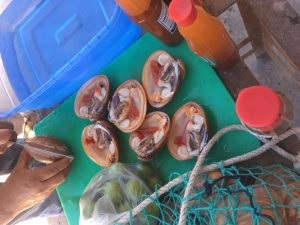I’ve never been a “shell-fish person”. In fact, while growing up, my family often got fresh mussels from the beach and prepared it for special occasions, while I sat looking terrified at the idea of eating an animal that came from a shell.
Two days ago on our trip to Puerto Libertad, a town about three hours from Kino, I changed my mind. For the first time, I tried shell-fish and really enjoyed it. Perhaps it was the historical and economic importance of this food-source. Or perhaps it was the context in which I was trying the shell-fish. Or perhaps it was the freshness, the sauces, the gastronomic value of the clams. Most probably, it was the combination of factors that created a perfect combination for the tastiest shell-fish I have ever had.
Alemejas, clams in Spanish, are an important food source in the region. There are multiple kinds of clams eaten and harvested: white, red and chocolate clams. These have historically been a stable food source for the region, although in more recent history, other sources of protein such as bovine meat and pig have gained a greater importance in the local diet. Nonetheless, clams still play an important part in the economy of coastal areas and in the food consumed, even in locations far from sea. At a whole-sale market, for example, each red clam will sell for at least two dollars. This historical and economic importance of clams has led to recent population declines of all species except for the chocolate clam. COBI, a civil society organization that works with marine conservation in Baja Califronia, Guaymas, Mexico City, and the Caribbean side of Mexico, implemented a model of sustainable fisheries management to recuperate the populations of clams. This model is being put into action in Puerto Libertad, the town where I was lucky enough to try these delicious creatures. The clams I got to try were a direct product of the resource management project that works with three clam fisheries cooperatives. The one we interacted with was led by Gabriel.
Our clam-chef, Gabriel, was the president of one of the cooperatives that works with COBI in the sustainable harvesting of clams in the region. While preparing fresh clams for us, Gabriel enthusiastically answered our questions and explained his role in the fishery industry. He plays an active role in maintaining the industry sustainable. For instance, his product has recently received more demand due to its sustainability from restaurants in Mexico City and resorts. However, Gabriel sees himself as a protector of the clam populations and has recently struggled with meeting demand while still ensuring that clam populations are maintained at sustainable levels. Each bite of clam demonstrated Gabriel’s dedication in his cooperative, in his work with COBI and in ensuring that clams continue to feed people sustainably.
History, economic importance, sustainability and Gabriel’s dedication were large components to why, for the first time, I was able to appreciate shellfish. I cannot deny, however, that the freshness, the delicate preparation and our location, also played a role. To start, I witnessed the freshness of the clams as soon as we walked up to the gazebo where Gabriel was waiting to prepare clams for us. Gabriel had received the clams from fishers that morning. Wrapped around a net, the clams still had the smell of salt-water. As soon as we arrived, he began opening them, carefully cutting out the parts that we were to eat (all but the gonads and the intestines). Each half-clam was individually rinsed and put aside or a brief second. He began preparing it, and I saw what seemed to be an unusual combination: chilli, Worcester sauce, soy sauce, lime, hot sauce, oyster sauce, a pinch of salt and a pool of Clamato, a drink comprised of clam powder and tomato juice. Together, these flavours mixed with the firm texture and sweet taste of the clams to create a flavourful explosion for my taste buds. All of this, happening meters away from the beach, the pristine blue water, and tall, arid mountains in the distance.
I guess I can safely say that there was no possible way that I could have not enjoyed the clams. With each piece of clam, I understood a part the puzzle that made clams so delicious and important. One bite: history. One bite: economic importance to the area. One bite: sustainability successes. One bite: pure dedication. One bite: intense flavour. Together, these formed explosions in my mouth and created an appreciation for these shelled-beauties that I would have never had otherwise. After consuming multiple clams, I guess I can safely say now that I am a “shell-fish person”.
Beautiful red clams prepared for us by Gabriel (Photo taken by Rachel Cohn)
Beach close in Puerto Libertad, close to where the preparation of the clams took place.


